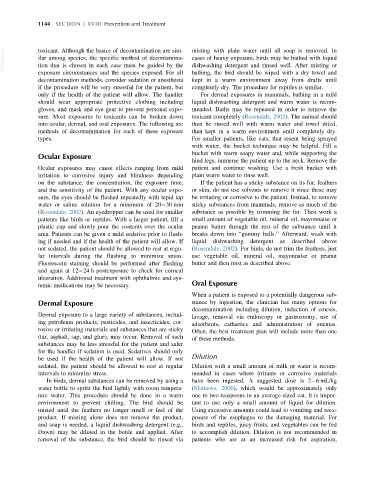Page 1213 - Veterinary Toxicology, Basic and Clinical Principles, 3rd Edition
P. 1213
1144 SECTION | XVIII Prevention and Treatment
VetBooks.ir toxicant. Although the basics of decontamination are sim- misting with plain water until all soap is removed. In
cases of heavy exposure, birds may be bathed with liquid
ilar among species, the specific method of decontamina-
dishwashing detergent and rinsed well. After misting or
tion that is chosen in each case must be guided by the
exposure circumstances and the species exposed. For all bathing, the bird should be wiped with a dry towel and
decontamination methods, consider sedation or anesthesia kept in a warm environment away from drafts until
if the procedure will be very stressful for the patient, but completely dry. The procedure for reptiles is similar.
only if the health of the patient will allow. The handler For dermal exposures in mammals, bathing in a mild
should wear appropriate protective clothing including liquid dishwashing detergent and warm water is recom-
gloves, and mask and eye gear to prevent personal expo- mended. Baths may be repeated in order to remove the
sure. Most exposures to toxicants can be broken down toxicant completely (Rosendale, 2002). The animal should
into ocular, dermal, and oral exposures. The following are then be rinsed well with warm water and towel dried,
methods of decontamination for each of these exposure then kept in a warm environment until completely dry.
types. For smaller patients, like cats, that resent being sprayed
with water, the bucket technique may be helpful. Fill a
bucket with warm soapy water and, while supporting the
Ocular Exposure
hind legs, immerse the patient up to the neck. Remove the
Ocular exposures may cause effects ranging from mild patient and continue washing. Use a fresh bucket with
irritation to corrosive injury and blindness depending plain warm water to rinse well.
on the substance, the concentration, the exposure time, If the patient has a sticky substance on its fur, feathers
and the sensitivity of the patient. With any ocular expo- or skin, do not use solvents to remove it since these may
sure, the eyes should be flushed repeatedly with tepid tap be irritating or corrosive to the patient. Instead, to remove
water or saline solution for a minimum of 20 30 min sticky substances from mammals, remove as much of the
(Rosendale, 2002). An eyedropper can be used for smaller substance as possible by trimming the fur. Then work a
patients like birds or reptiles. With a larger patient, fill a small amount of vegetable oil, mineral oil, mayonnaise or
plastic cup and slowly pour the contents over the ocular peanut butter through the rest of the substance until it
area. Patients can be given a mild sedative prior to flush- breaks down into “gummy balls.” Afterward, wash with
ing if needed and if the health of the patient will allow. If liquid dishwashing detergent as described above
not sedated, the patient should be allowed to rest at regu- (Rosendale, 2002). For birds, do not trim the feathers, just
lar intervals during the flushing to minimize stress. use vegetable oil, mineral oil, mayonnaise or peanut
Fluorescein staining should be performed after flushing butter and then mist as described above.
and again at 12 24 h postexposure to check for corneal
ulceration. Additional treatment with ophthalmic and sys-
Oral Exposure
temic medications may be necessary.
When a patient is exposed to a potentially dangerous sub-
Dermal Exposure stance by ingestion, the clinician has many options for
decontamination including dilution, induction of emesis,
Dermal exposure to a large variety of substances, includ-
lavage, removal via endoscopy or gastrostomy, use of
ing petroleum products, pesticides, and insecticides, cor-
adsorbents, cathartics and administration of enemas.
rosive or irritating materials and substances that are sticky
Often, the best treatment plan will include more than one
(tar, asphalt, sap, and glue), may occur. Removal of such
of these methods.
substances may be less stressful for the patient and safer
for the handler if sedation is used. Sedatives should only
be used if the health of the patient will allow. If not Dilution
sedated, the patient should be allowed to rest at regular Dilution with a small amount of milk or water is recom-
intervals to minimize stress. mended in cases where irritants or corrosive materials
In birds, dermal substances can be removed by using a have been ingested. A suggested dose is 2 6 mL/kg
water bottle to spritz the bird lightly with room tempera- (Mathews, 2006), which would be approximately only
ture water. This procedure should be done in a warm one to two teaspoons in an average-sized cat. It is impor-
environment to prevent chilling. The bird should be tant to use only a small amount of liquid for dilution.
misted until the feathers no longer smell or feel of the Using excessive amounts could lead to vomiting and reex-
product. If misting alone does not remove the product, posure of the esophagus to the damaging material. For
and soap is needed, a liquid dishwashing detergent (e.g., birds and reptiles, juicy fruits, and vegetables can be fed
Dawn) may be diluted in the bottle and applied. After to accomplish dilution. Dilution is not recommended in
removal of the substance, the bird should be rinsed via patients who are at an increased risk for aspiration,

